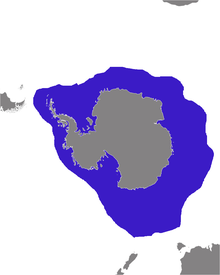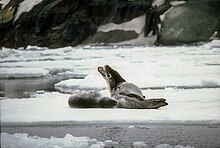Leopard seal
| Leopard seal | ||||||||||||
|---|---|---|---|---|---|---|---|---|---|---|---|---|

Leopard seal |
||||||||||||
| Systematics | ||||||||||||
|
||||||||||||
| Scientific name of the genus | ||||||||||||
| Hydrurga | ||||||||||||
| Gistel , 1848 | ||||||||||||
| Scientific name of the species | ||||||||||||
| Hydrurga leptonyx | ||||||||||||
| ( Blainville , 1820) |
The leopard seal ( Hydrurga leptonyx ) is a seal that is common in southern polar waters . It got its name because of its spotted fur and because it is a predator that prey on small animals ( krill ) and fish as well as warm-blooded vertebrates such as penguins and young seals of other species.
features
Leopard seals have a very streamlined body that allows them to reach considerable speeds in the water. Her head is unusually flattened and almost looks like a reptile . The front fins are greatly elongated; the leopard seal moves in the water with powerful, simultaneous blows of these front fins, it can reach a speed of 40 km / h. A male leopard seal is about three meters long, while females can be nearly four meters long. The weight of a male is 270 kg, that of a female almost 400 kg. The color is dark gray on top and silvery white on the underside with gray spots on the head and flanks.
habitat
The leopard seal is an animal of the Antarctic seas. It moves around the Antarctic continent on the edge of the pack ice. Young animals in particular often go ashore on the coasts of sub-Antarctic islands and can be found there all year round. Wandering or stray animals rarely make their way to Australia , New Zealand , South Africa or Tierra del Fuego .
Way of life
nutrition
In addition to the killer whale , the leopard seal is the dominant predator of the southern polar region. He often represents the crab-eaters , the Weddell seals , the fur seals to and the penguins. Some leopard seals specialize in seal hunting, while others mainly hunt penguins. If possible, the prey is packed in the water and killed. However, if the animals flee onto the ice, the leopard seal occasionally follows them there. Crab eaters in particular often have scars from attacks by leopard seals.
Remarkably, the leopard seal equally feeds on krill, ie small crustaceans of the plankton as large vertebrates. Fish, on the other hand, play a subordinate role in its diet. He filters the krill with a system of tubes in his molars that is similar to that of the crabeater, but not nearly as complex. Through recesses in its teeth, it can squeeze water out of its mouth while the krill gets stuck.
On average, the diet of a leopard seal consists of 45% krill, 35% seals, 10% penguins and 10% other animals (fish, cephalopods ).
Reproduction
Leopard seals are solitary animals. Only younger animals sometimes come together in small groups. Mating takes place in the water between November and February. In addition, males and females do not maintain contact. The only boy born on the pack ice between September and January is suckled for four weeks. At three to four years of age, leopard seals are sexually mature and their life expectancy is around 25 years.
Others
After the crabeater and the Weddell seal, the leopard seal is the most common seal in Antarctica. It is estimated that 400,000 individuals live in the southern polar seas. Of natural enemies, leopard seals only have to fear killer whales , which, however, according to the observations of marine biologists Robert Pitman and John Durban, only attack and capture leopard seals when food is scarce. The species does not currently appear to be threatened.
The Canadian nature photographer Paul Nicklen , whose underwater close-ups of the penguin hunt of a female leopard seal won several prizes in 2007, reported on the animal's peaceful contact. This even repeatedly brought him his prey and laid it for example. B. on the camera. The photographer said that the animals are rarely aggressive towards people diving with them , but rather curious.
Leopard seal and human
Leopard seals are among the animals that are potentially dangerous for humans. Despite this danger, only a few attacks have been reported. However, examples of aggressive behavior towards people in the vicinity and attacks were documented. The seals attacked boats or suddenly jumped out of the water to grab a leg. Staff at research stations were always affected. Such attacks are probably due to the fact that leopard seals quite often try to grab prey (in this case mainly penguins) standing on the edge of the ice. Precise identification of the prey is likely to be difficult.
Notable incidents:
- The attack of a large leopard seal on Thomas Orde-Lees (1877-1958), a member of the Endurance Expedition (1914-1917) led by Sir Ernest Shackleton . The attack occurred when the crew was making camp on the ice. A 3.7 meter long, 500 kg heavy leopard seal followed Thomas Orde-Lees over the ice. This was saved when a member of the expedition shot the leopard seal.
- In 1995, Scottish explorer Gareth Wood was bitten twice in the leg when a leopard seal tried to pull him off the ice and into the water. His companions were able to save him by repeatedly kicking the leopard seal in the head with their crampons .
- On July 22, 2003, British scientist Kirsty Brown of the British Antarctic Survey was attacked and killed by a leopard seal while snorkeling near the Rothera research station . This is the only known death from a leopard seal.
Leopard seals seem to have a great predilection for attacking the black, torpedo-shaped pontoons of rigid inflatable boats . It was therefore necessary to provide them with a special protection to protect them against perforation.
literature
- Ronald M. Nowak: Walker's Mammals of the World . 6th edition. Johns Hopkins University Press, Baltimore 1999, ISBN 0-8018-5789-9 .
Web links
- Hydrurga leptonyx in the Red List of Threatened Species of the IUCN 2006. Posted by: Seal Specialist Group, 1996. Retrieved on 12 May, 2006.
Individual evidence
- ↑ Kim Heacox, Paul Nicklen: Death in the Antarctic. (No longer available online.) In: Website of National Geographic Germany . November 1, 2006, archived from the original on May 29, 2009 ; Retrieved October 20, 2012 . Info: The archive link was inserted automatically and has not yet been checked. Please check the original and archive link according to the instructions and then remove this notice.
- ^ A b c Carrington, Damian (July 24, 2003). Inquiry into fatal leopard seal attack begins . NewScientist.com. Retrieved February 24, 2013.
- ↑ a b c d James Owen: Leopard Seal Kills Scientist in Antarctica. In: NationalGeographic.com. August 6, 2003, accessed December 10, 2007 .


